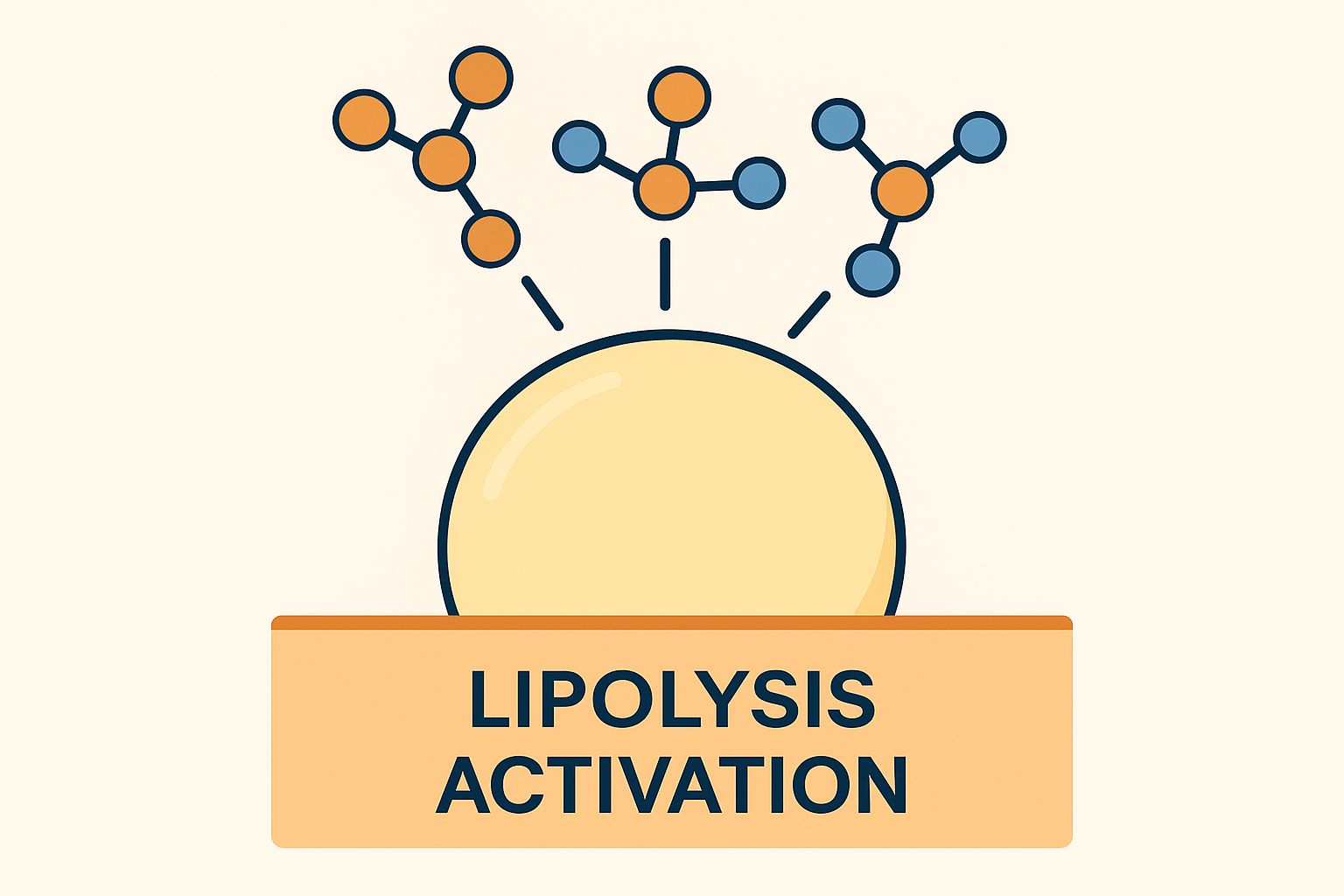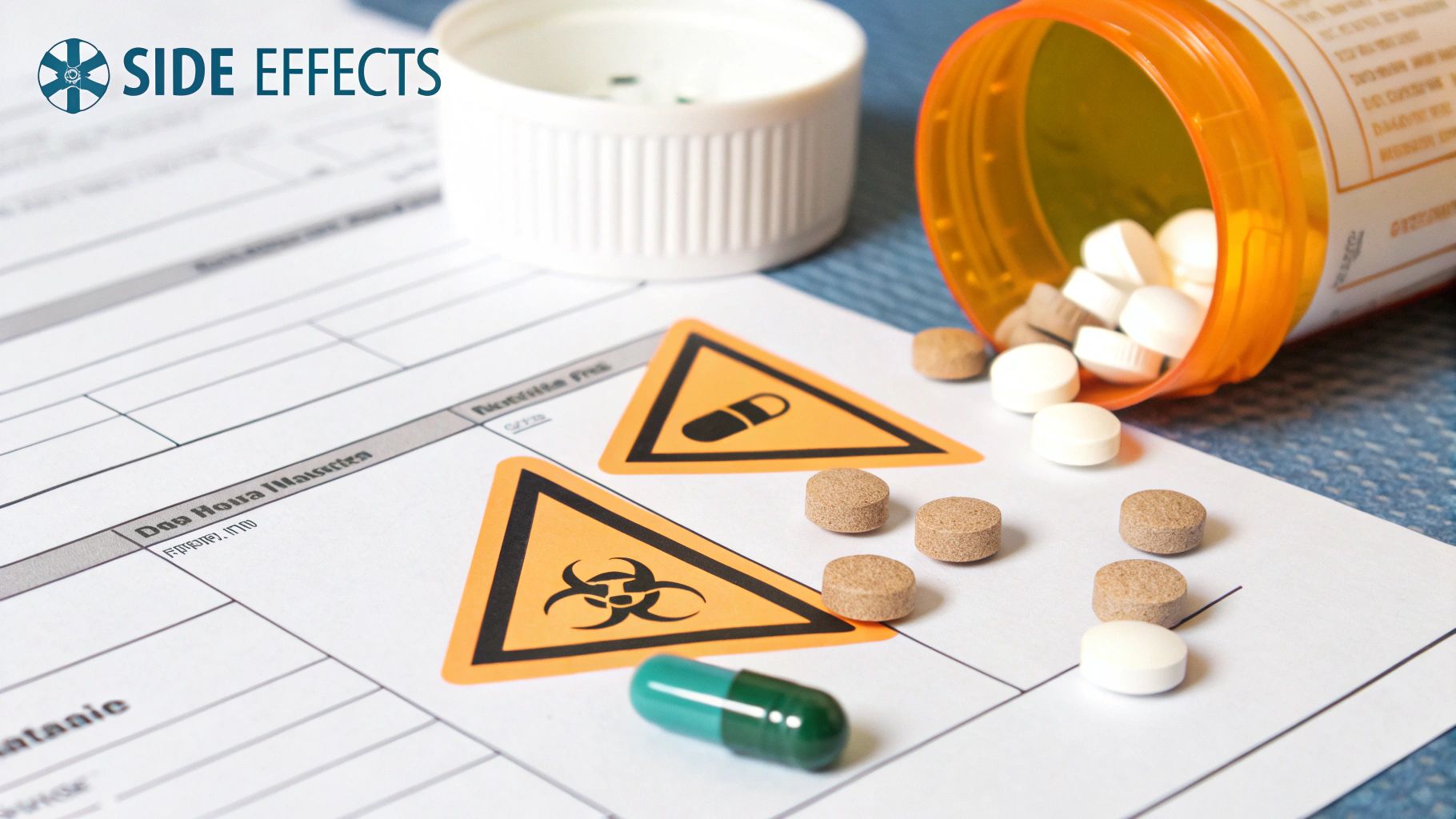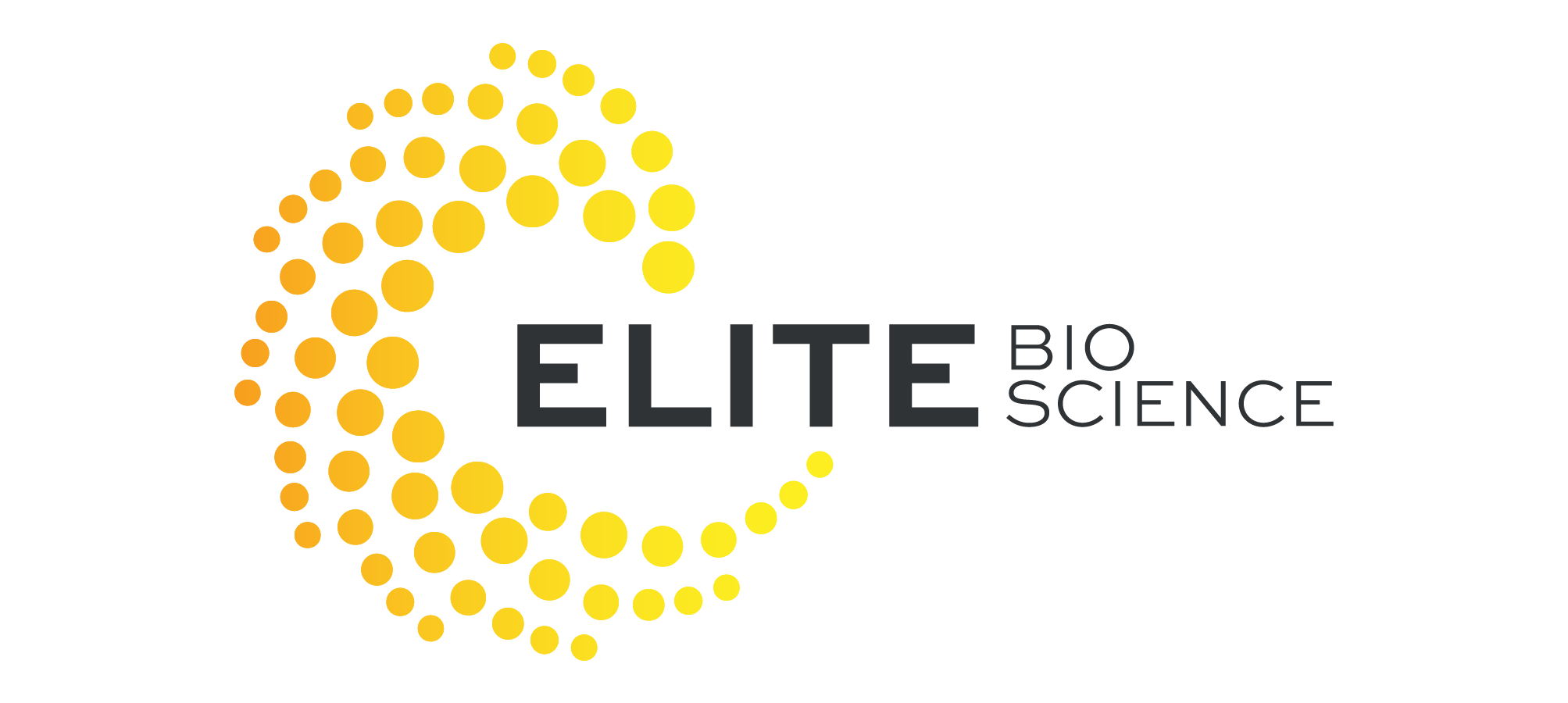Understanding How Your Body’s Hunger Signals Actually Work
Think of your body’s hunger and fullness cues as a sophisticated conversation between your gut, brain, and fat cells. In a perfect world, this communication network is flawless. Your stomach sends a message to your brain saying, “I’m full,” and you comfortably put down your fork. Your fat cells signal, “We have plenty of energy stored,” and your appetite naturally fades. But modern life—full of processed foods, stress, and hectic schedules—can create static on this line, disrupting the entire conversation.
This is where peptides for weight loss come in, acting like expert translators to restore clarity. Instead of forcing yourself into a battle against your own biology with willpower, which often proves futile, these treatments work with your body. When a diet doesn’t work, it’s rarely a sign of weakness; more often, it’s your biology pushing back. Peptides help correct the underlying communication breakdown, making weight management feel natural and sustainable, not restrictive and frustrating.
The Science of Satiety and Appetite
At the heart of this internal system are hormones that serve as chemical messengers. Two of the most critical players are Ghrelin, often called the “hunger hormone,” and GLP-1 (glucagon-like peptide-1), a key “satiety hormone.” When your stomach is empty, ghrelin levels climb, sending a potent “it’s time to eat” signal to your brain. After you finish a meal, your intestines release GLP-1, which travels to the brain to deliver the message, “We’re satisfied now, you can stop eating.”
Many of today’s weight loss peptides, such as semaglutide and tirzepatide, are engineered to mimic or boost the action of GLP-1. By doing so, they produce several powerful effects:
- They slow down the rate at which your stomach empties, helping you feel physically full for much longer after a meal.
- They send direct signals to the appetite control centers in your brain, which helps diminish cravings and the overall impulse to eat.
- They assist in regulating blood sugar and insulin, preventing the sharp spikes and subsequent crashes that can trigger intense hunger and promote fat storage.
You can take a closer look at how these complex systems are managed by reading our guide on understanding appetite regulation and how peptides can help control cravings.
Real-World Efficacy: Why Peptides Are So Effective
The power of these peptide-based treatments isn’t just a theory; it’s strongly supported by clinical evidence. The latest research shows how certain peptides are transforming obesity treatment. For example, a landmark 40-week phase 3 trial involving 1,973 patients with type 2 diabetes directly compared tirzepatide and semaglutide. The findings revealed tirzepatide’s superior outcomes, with patients losing an average of 4 to 12 more pounds than those using semaglutide, while also showing greater improvements in metabolic health.
You can discover more insights about peptide effectiveness at Innerbody.com to see more on this research. By re-establishing your body’s natural communication channels, these peptides do more than just trigger weight loss—they help create a new, healthier metabolic balance.
Decoding the Major Weight Loss Peptides That Actually Work
Diving into the world of peptides for weight loss can feel like staring at a restaurant menu with dozens of options, each promising fantastic results. The secret is knowing that different peptides have unique jobs, making some a better fit for your specific goals than others. While many compounds are available, a select few have become leaders because of their proven results and strong scientific support.
The most prominent players are the GLP-1 and dual-action agonists. These aren’t just technical terms; they describe how peptides interact with your body to manage weight. Imagine them as different types of metabolic coaches. One coach might specialize in silencing hunger signals, while another excels at both appetite control and improving how your body uses sugar.
Tirzepatide and Semaglutide: The Heavy Hitters
When you talk about peptides for weight loss, two names are always at the top of the list: semaglutide and tirzepatide. These are the active ingredients in well-known medications and have been studied extensively, solidifying their reputation.
- Semaglutide: This peptide is a GLP-1 receptor agonist. It works by imitating the GLP-1 hormone your gut naturally releases after you eat. Its main functions are to slow down how quickly your stomach empties—keeping you full for longer—and to tell your brain you’re satisfied, which dials down hunger and cravings. It’s a great option for people whose biggest challenge is managing their appetite.
- Tirzepatide: This peptide uses a dual-action strategy. It acts as both a GLP-1 and a GIP (glucose-dependent insulinotropic polypeptide) receptor agonist. By activating two distinct hormonal pathways, tirzepatide not only curbs appetite but also improves insulin sensitivity and overall metabolic function. This two-in-one approach often produces more dramatic weight loss, with clinical trials showing users can lose up to 15% of their body weight.
Both are highly effective, but the choice between them often comes down to your individual metabolic needs and weight loss objectives.
To help you see how these powerful peptides stack up, we’ve created a comparison guide. This table breaks down their mechanisms, effectiveness, and typical use so you can better understand their unique strengths.
Complete Peptide Comparison Guide
Side-by-side analysis of effectiveness, mechanisms, dosing schedules, and real-world results for major weight loss peptides
| Peptide Name | How It Works | Expected Weight Loss | Injection Schedule | Best For |
|---|---|---|---|---|
| Semaglutide | Mimics the GLP-1 hormone to slow digestion, suppress appetite, and signal fullness to the brain. | 10-15% of body weight | Once weekly | Individuals focused on powerful appetite control and reducing cravings. |
| Tirzepatide | Acts on both GLP-1 and GIP receptors for a dual effect on appetite suppression and metabolic enhancement. | Up to 15% or more of body weight | Once weekly | People needing significant weight loss and improved metabolic function (insulin sensitivity). |
| CJC-1295/ Ipamorelin | Stimulates natural growth hormone release from the pituitary gland. | Varies; focused on fat loss & muscle gain | Daily or 5 days/week | Those wanting to burn fat while preserving or building lean muscle. |
| MOTS-c | Regulates metabolism at the cellular level by mimicking the metabolic benefits of exercise. | Varies; focused on metabolic efficiency | 2-3 times per week | Individuals looking to improve insulin sensitivity and boost fat-burning at a cellular level. |
This table shows that while Semaglutide and Tirzepatide are the primary drivers for significant weight loss through appetite suppression, other peptides like CJC-1295/Ipamorelin and MOTS-c offer specialized benefits. They can be excellent additions for optimizing body composition and metabolic health.
Emerging and Specialized Peptides
Beyond the two giants, other peptides provide more targeted effects, often concentrating on processes like fat breakdown (lipolysis) or protecting muscle tissue. These are sometimes included in combination plans to achieve a more complete result.
- CJC-1295/Ipamorelin: This well-known duo works by encouraging your body’s natural release of growth hormone. Higher growth hormone levels can help speed up fat loss, enhance recovery, and build or maintain lean muscle, which is essential for a high-functioning metabolism.
- MOTS-c: This is a remarkable mitochondrial-derived peptide. It helps manage metabolism on a cellular level, essentially replicating some of the metabolic advantages of exercise. It is recognized for improving insulin sensitivity and helping the body use fat for fuel.
The infographic below illustrates how certain peptides can directly signal fat cells to release their stored energy.

This process, called lipolysis activation, is a key way specialized peptides can boost fat reduction beyond just suppressing your appetite. By understanding these different approaches, you and your healthcare provider can make an informed choice about which peptide therapy is the right match for your biology and goals.
Why Everyone’s Suddenly Talking About Peptide Weight Loss
The recent explosion of interest in peptides for weight loss isn’t just another wellness fad. It marks a fundamental change in how we think about obesity—moving from a frustrating battle of willpower against biology to a strategy that works with the body’s natural systems. For years, the choices were limited: diet and exercise plans with low long-term success rates, or invasive bariatric surgery. Peptides have arrived to fill the huge void in between, offering a medical approach that is backed by science, highly effective, and non-surgical.
This breakthrough is the result of decades of hormone research finally reaching the public, amplified by high-profile success stories that have brought these treatments into the spotlight. What’s emerged is a solution that finally targets the biological roadblocks—like hormonal signals and constant hunger—that make lasting weight loss feel impossible for so many.

A Market Responding to Unmet Needs
The massive demand for these treatments shows just how many people have been waiting for a real solution. This interest has sparked rapid market growth, proving the treatment’s impact. The global anti-obesity drug market, mostly driven by peptide therapies, was valued at around $6 billion in 2023. Projections show this market is set to skyrocket, with some estimates suggesting it could increase by more than 16-fold by 2030.
In the U.S. alone, the medical weight loss industry reached $33.8 billion in 2024. This figure more than doubled from 2022, largely because of the boom in prescriptions for GLP-1 medications. You can read more about these market forecasts and their implications to grasp the scale of this shift.
Democratizing Treatment Through Accessibility
Not long ago, advanced weight management solutions were available only to a select few. That is starting to change. As more peptide-based drugs receive FDA approval and public awareness grows, insurance coverage is slowly expanding. This trend is helping to make effective obesity care accessible to a much wider population that desperately needs it.
This has also led to demand that has, at times, outrun supply. The popularity of medications like Semaglutide has caused occasional shortages, underscoring the need for reliable access and other options. If you want to dive deeper into this topic, you can learn more about the weight loss medication shortage and how it affects patients. The conversation around peptide weight loss is growing louder because it offers hope and a real, biologically-sound plan for millions who thought they were out of options.
What Actually Happens When You Start Peptide Treatment
Starting a journey with peptides for weight loss is often a mix of excitement and a little bit of the unknown. Beyond the clinical studies and marketing claims, the real-world experience is a personal process of your body adapting and you discovering a new relationship with food. Knowing what to expect week by week can help you manage expectations and recognize progress, which isn’t always just about the number on the scale.
Based on patient stories and provider insights, a general timeline tends to emerge, but remember—everyone’s body responds differently. Your first injection might come with some nervousness, but the process is surprisingly simple. Some people feel an immediate shift in their appetite within the first week, noticing they get full much faster. For others, the initial effects are more subtle, taking a few weeks of consistent use and dose adjustments to find their “sweet spot.”
The First Month: Adjustment and Early Changes
This initial phase is all about your body getting used to the treatment. It’s when you’re most likely to notice side effects, which are usually mild and temporary. Nausea, a bit of fatigue, or some digestive changes are common but typically fade as your system adjusts to the peptide.
- Weeks 1-2: You might notice a quieting of “food noise”—that nonstop mental chatter about what to eat next. Cravings for salty snacks or sweets can start to fade, and you may find yourself leaving food on your plate for the first time in years. Weight loss at this point is often minimal because the main effect is regulating your appetite, not just shedding pounds.
- Weeks 3-4: As your body adapts, the appetite-suppressing effects become more reliable. You may begin to see a steady, gradual drop in weight. This is the perfect time to focus on building healthy habits, like prioritizing protein and staying hydrated, which helps manage side effects and supports your results.
Finding Your Rhythm: Months Two and Three
By the second and third months, most people have settled into a comfortable routine. Side effects have usually disappeared, and you’ve likely worked with your provider to find a dose that works best for you. This period is often where the most significant physical changes happen, as the sustained calorie deficit from a reduced appetite leads to more consistent fat loss.
However, this is also when you might hit your first weight-loss plateau. This is a completely normal part of any weight management journey. Instead of feeling discouraged, see it as a signal to reassess your approach. Are you getting enough protein to preserve muscle? Are you incorporating movement into your routine? Tracking progress with photos, body measurements, and how your clothes fit can paint a much fuller picture of success than the scale alone. Success isn’t just about losing pounds; it’s about gaining control and improving your metabolic health.
To give you a clearer picture, the table below breaks down what a real-world peptide journey often looks like, combining patient experiences with clinical expectations.
Real-World Peptide Timeline
Month-by-month breakdown of typical experiences, challenges, and milestones based on actual patient data
| Time Period | What to Expect | Common Challenges | Success Markers | Action Steps |
|---|---|---|---|---|
| Month 1 | Reduced appetite, less “food noise,” possible mild side effects (nausea). | First injection anxiety, adjusting to new eating patterns. | Feeling full faster, reduced cravings, slight initial weight loss. | Stay hydrated, eat small, protein-rich meals, track side effects. |
| Months 2-3 | More consistent weight loss, increased energy, side effects diminish. | Hitting a weight loss plateau, staying motivated. | Clothes fitting better, noticeable body composition changes. | Incorporate resistance training, adjust diet, talk to your provider. |
| Months 4-6 | Establishing long-term habits, feeling more in tune with hunger cues. | Managing social situations involving food, planning for maintenance. | Reaching initial goals, improved health markers (blood pressure, etc.). | Discuss long-term strategy, focus on sustainable lifestyle habits. |
This timeline shows that peptide therapy is a process of continuous adjustment. The first month is about adaptation, the next few months are about building momentum, and the later stages are about creating sustainable habits for long-term health.
Mastering Dosing and Administration for Maximum Results

Using peptides for weight loss effectively isn’t just about picking the right one—it’s about how you use it. Think of it like tuning a high-performance engine. Shoving in too much fuel at once won’t make the car faster; it will flood the engine and cause it to stall. In the same way, starting with a high dose of peptides can overwhelm your body, leading to more side effects than results.
This is why experienced healthcare providers almost always begin with a slow titration approach. This method involves starting with a very low dose and gradually increasing it over weeks or months. It gives your body time to acclimate, which dramatically lowers the chance of side effects like nausea or fatigue. Finding your ideal dose is a team effort with your provider, aiming for that “sweet spot” where you get all the benefits with minimal discomfort.
The Art of Titration: Finding Your Sweet Spot
Titration is the key to a successful peptide protocol. It’s a patient, careful process designed to find the most effective dose for your specific biology. While jumping straight to a high dose might seem like a shortcut, it usually backfires. A gradual increase allows you and your provider to see how you feel and respond at every single step.
So, when is an adjustment needed?
- Plateaued Progress: If your weight loss stalls for a few weeks even with consistent habits, it may be time to discuss a dose increase with your provider.
- Waning Appetite Control: If you notice the “food noise” or strong cravings coming back, your body might have adapted to the current dose.
- Persistent Side Effects: On the flip side, if side effects don’t go away after the initial adjustment period, your dose might be too high. A reduction could be the answer.
Being your own advocate is crucial. Keep a simple journal to log your dose, how you feel, and any side effects. This information is incredibly useful for having productive talks with your provider to fine-tune your protocol.
Practical Administration for Consistent Results
Beyond the dosage amount, how you administer and store your peptides is essential for making sure they work. Most weight loss peptides are given via subcutaneous injection, which means injecting them into the fatty tissue just under the skin. It might sound intimidating, but it’s a straightforward and nearly painless process once you learn the right technique.
Best practices for injections include:
- Rotating Injection Sites: To prevent skin irritation and ensure the peptide is absorbed evenly, regularly switch between areas like your abdomen, thigh, or upper arm.
- Proper Technique: The standard method is to pinch a fold of skin and inject at a 90-degree angle (or a 45-degree angle if you have very little body fat).
- Using Sterile Equipment: Always use a new, sterile needle for every injection to avoid any risk of infection.
Proper storage is just as important. Peptides are delicate molecules that can break down if exposed to heat or light. Most must be kept in the refrigerator to stay potent. Leaving a vial on the counter could make it useless, wasting both your time and money. Always follow the storage directions from your pharmacy or clinic to ensure you get the full benefit of every single dose. By mastering these practical details, you empower yourself to get the best possible results.
Turning Side Effects Into Success Strategies
When you start a new treatment like peptides for weight loss, it’s common to experience some side effects as your body adjusts. While feeling nauseous or tired can be concerning, these initial hurdles don’t mean you have to stop. Think of them as signposts, indicating the treatment is starting to work and guiding you toward your long-term goals.
The most frequent side effects, including mild nausea, digestive shifts, and fatigue, often signal that the peptide is doing its job. For example, nausea is a common response because the peptide is slowing down how quickly your stomach empties. This is a core mechanism for making you feel full longer, but your digestive system needs a moment to catch up. It’s a lot like starting a new workout routine—you expect some muscle soreness at first before you start feeling stronger. Most of these initial effects are temporary and usually fade within the first few weeks.
Proactive Strategies for Common Side Effects
Instead of just waiting for side effects to go away, you can take simple, active steps to lessen their impact. In fact, over 95% of patients handle peptide therapy well, and a few small adjustments can make the experience even better. These strategies are tools to help your body and the medication work together smoothly.
- For Nausea and Digestive Upset: These are the most commonly reported issues, and the solution is to avoid overwhelming your digestive system. Try eating smaller, more frequent meals instead of three large ones. Focus on protein-rich foods that promote fullness without feeling heavy. Sipping water throughout the day is key, and you might also find relief with ginger tea or peppermint, both known for their stomach-soothing properties.
- For Fatigue: A temporary drop in energy can happen as your body recalibrates its metabolic engine. Make sure you’re getting enough quality sleep and don’t be afraid to rest when you need to. A balanced diet is also essential; a drastic calorie drop can lead to fatigue, so prioritize nutrient-dense foods. Even gentle movement, like a daily walk, can boost your energy more than staying still.
Lifestyle Changes That Amplify Results
Managing side effects is one part of the equation. The other is adopting lifestyle habits that boost the benefits of your peptide therapy. These changes work in harmony with the medication to create a powerful formula for lasting success.
Here are a few complementary actions to consider:
- Strategic Meal Timing: Try to eat your larger meals earlier in the day when your digestive system is naturally more active. Eating a big meal right before bed can lead to discomfort overnight due to the slowed digestion caused by the peptide.
- Supportive Supplements: While they don’t replace a healthy diet, certain supplements can be helpful. A high-quality electrolyte powder can help combat dehydration and fatigue. A probiotic can also support your gut health as it adjusts to the new treatment.
- Mindful Eating: Pay close attention to your body’s new signals for fullness. Peptides help you feel satisfied with less food, so learning to stop eating when you’re comfortably full—not stuffed—is a new and important skill to develop.
By actively managing these early challenges, you can seamlessly integrate peptide therapy into your life, ensuring that temporary discomfort makes way for lasting results and better health.
The Evolution of Peptide Weight Loss Treatment
The incredible success of **peptides for weight loss** isn’t the final destination; it’s the start of a whole new chapter in metabolic medicine. While today’s treatments are powerful, the future holds the promise of even more effective and refined options. Researchers are already looking beyond the current GLP-1 agonists to create therapies that are more targeted, easier to use, and customized for each person.
This push forward is backed by massive market demand. The glucagon-like peptide-1 (GLP-1) market, which is home to the top weight loss drugs, was valued at around $20.88 billion in 2024. Projections show it soaring to $31.27 billion by 2029, a clear indicator of the urgent need for better obesity treatments. You can read the full research about this expanding market to understand how this growth is fueling medical breakthroughs.
Next-Generation Peptides and Delivery Methods
The next wave of weight loss therapies is all about hitting multiple biological targets at once. Scientists are crafting “multi-agonist” peptides, similar to how tirzepatide works, that can influence several hormone receptors at the same time. Picture a single treatment that not only curbs your appetite and improves insulin function but also ramps up your energy use and safeguards your muscle mass. These advanced compounds aim to produce greater weight loss with fewer side effects.
On top of that, the era of weekly injections might be coming to an end. Research is actively exploring new ways to deliver these peptides, including:
- Oral Peptides: A daily pill could eliminate the need for injections, making treatment far more approachable and less intimidating for many.
- Long-Acting Injectables: Formulas requiring just one injection per month or even less are already in clinical trials, offering unmatched convenience.
- Transdermal Patches: Needle-free patches that deliver a consistent dose of medication through the skin are also on the horizon.
The Rise of Personalized Peptide Protocols
Maybe the most exciting progress is the move toward personalized medicine. In the near future, treatment plans might use your genetic profile to determine which peptide will work best for your body. Artificial intelligence (AI) could analyze health data in real time to adjust dosing, maximizing results while keeping side effects to a minimum.
This customized strategy acknowledges that weight management is not a one-size-fits-all challenge. By seeing what’s coming, you can better appreciate how today’s peptides are part of a bigger, evolving picture of health. Many of these therapies also offer major benefits beyond just weight loss, which you can learn about in our article on the cardiovascular and glucose health benefits of semaglutide and tirzepatide.
Are you ready to see how today’s leading peptide therapies can support your health journey? Discover tailored peptide solutions at Elite Bioscience and take the first step toward a healthier future.







